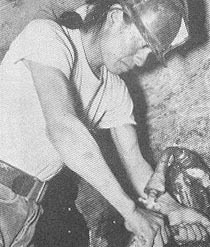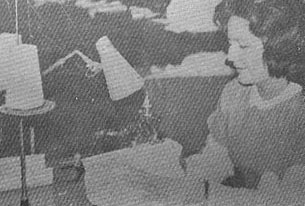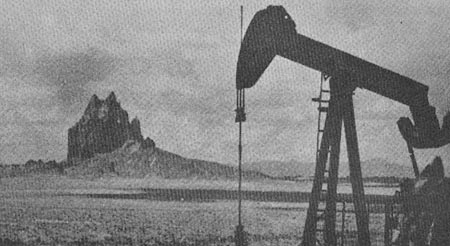

Diné Miners Suffer Extreme National and Class Oppression
The Diné people have suffered immeasurably at the hands of U.S. imperialism. To this day they are threatened with the loss of their land, their means of livelihood and with the destruction of their entire people. They have been forced into wage labor under the worst conditions. The plight of the Diné uranium miners is a case in point.
After World War II, the conditions in the Diné homeland were extremely difficult. Many who had left their homes to seek employment in booming industry or the military during the war now returned. But the traditional economy had almost been destroyed by U.S. oppression and exploitation. Therefore, when U.S. monopolies began uranium mining on Diné land, many men had no choice but to go into the mines.
The leases negotiated between the Bureau of Indian Affairs and the monopolies for Diné uranium and coal were little more than legal theft of these resources. There were no protections for the land and environment or for the people who would work in the mines. Kerr-McGee, the largest uranium mining company in the U.S., opened a mine at Red Rock in 1949. This mine operated until 1969. Kerr-McGee also operated a uranium milling plant near Shiprock. All uranium from this mine was sold to the U.S. government's Atomic Energy Commission. A spokesman from the Red Rock community described the conditions in the mine:
The miners drilled, blasted and hauled uranium from the mines in wheel barrows. Thirty minutes after the blasting, the miners were sent back into the mines. It took the uranium dust a long time to settle. They were not given any protective clothing or masks. There was no ventilation or drinking water. The miners drank water that seeped through the walls of the mines. The water was contaminated with radioactive particles from the drilling. The mine was two miles long and one mile deep. For all of this, they were paid $1.60 an hour.
No federal or state agency would take responsibility for establishing or enforcing safety standards in the uranium mines. This, despite the fact that the Atomic Regulatory Agency was charged with regulating all aspects of the nuclear energy industry, and the Labor Department had the authority to enforce safe working standards on an industry whose products are produced under federal government contracts. Not until 1967, just two years before the close of the Red Rock mine, were regular measurements taken and some standard for safety set. As a result of the collaboration between the government and the monopolies, the lives of the Diné miners were destroyed.
One former miner describes his experience:
I had the good fortune to be occupying a mining job, but after a few years the material things started to dwindle. Many of the people I had once been with in the mines were beginning to die. My heart weeps for them. I see Navajo widows trying to eke out a living, holding out their hands begging, trying to take care of their children.
Of one hundred Diné miners who worked at Red Rock, twenty-five have died of lung cancer and another twenty have already developed the disease. It is estimated that 70% of these miners will die of lung cancer and related diseases. A public health doctor reported on ten Diné uranium miners who died from lung cancer after 1970. The youngest was only 31 years old and the average age for the group was just 45 years. While the average time in the mines was 14 years, one miner had worked there only 5 years and still contracted the dread disease. Besides those who died or were disabled by cancer, the miners suffered from other debilitating diseases including pneumonia, thyroid tumors, heart problems, emphysema, pulmonary fibrosis, chronic bronchitis and other respiratory diseases.
 |
 |
The damage done to the Diné people by the uranium mining is not limited to the murdered and crippled uranium miners, nor to the grief of their families and communities. The extraction and milling of uranium produces thousands of tons of radioactive wastes, or tailings. These tailing were simply dumped near the mine sites or mills. The ground water became contaminated with radioactive wastes. No warnings were posted, nor were the local people told of the dangers of the radioactivity in the tailings. Homes were built from this radioactive material. No study has been done on the damage to the Diné people caused by this long-term exposure to radiation, but it will inevitably increase the rate of birth defects and cancer.
In 1979, there was a major break in a mud dam containing tailings from United Nuclear Corporation's Church Rock uranium mill. The resulting spill was the country's "worst in terms of contamination" according to the Nuclear Regulatory Commission. Nearly 100 million gallons of radioactive sludge and 1,000 tons of solids spilled into the Rio Puerco, a major source of water for the Diné.
Six weeks after the spill, a tribal survey found that at least fifteen adults and five children became ill from contact with the contaminated water and ten head of livestock had died. Seventeen people were still using river water for their livestock, while others were paying as much as $2 a barrel for water. Eight families did not have transportation to haul water. Shortly after the spill, the government tested ten children from the immediate area of the spill and claimed there was no increase in radiation. No further testing has been done.
So far the Diné have been unsuccessful in getting any reparations from Kerr-McGee, United Nuclear, the other uranium monopolies, or the federal and state governments for the deaths, injuries, and suffering caused by the uranium mining and processing on Diné lands. In the meantime, massive new uranium development is being undertaken. Government plans call for 100 uranium mines and 10 uranium mills by the year 2000 in the Four Corners area, which is populated primarily by Native peoples and Chicanos. In 1975, there were 380 uranium leases on Indian land (including Diné, Laguna Pueblo, Lakota and others). In 1977, the Labor Department gave Kerr-McGee $2 million for a training program that would provide 100 Navajo miners annually to meet the estimated need for 18,400 underground and 4,000 aboveground uranium miners by 1990.
The medical evidence shows that working in these mines and mills is a death sentence, yet the government is willing to spend millions to aid the monopolies in sending hundreds of Diné to their deaths. We must support the Diné struggle against this genocide. We must support the struggle for Diné self-determination, the right to political secession and complete control of their resources, lives and land.
 |
Click here to return to the U.S. Index